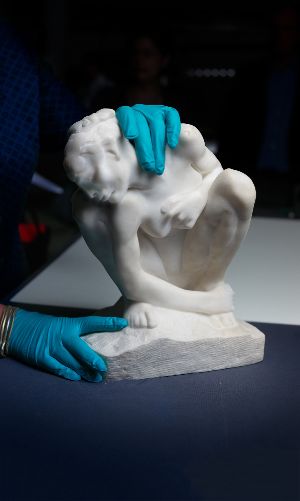Exhibition
Gurlitt: Status Report
An Art Dealer in Nazi Germany

Auguste Rodin (1840–1917), Crouching Woman. ca. 1882, Marble, www.lostart.de/521802 Kunstmuseum Bern, Legat Cornelius Gurlitt 2014, Photo: Albrecht Fuchs © Kunst- und Ausstellungshalle der Bundesrepublik Deutschland GmbH
News that the Bavarian Public Prosecutor’s office had seized the art collection of Cornelius Gurlitt (1932–2014), caused a national and international sensation when it was made public in November 2013. The 1500 works the reclusive son of the art dealer Hildebrand Gurlitt (1895–1956) had inherited from his father raised suspicions: had they been looted by the Nazis before and during the Second World War?
To investigate these suspicions and to study the cache, the German government provided funding to establish an international team of experts, the Schwabing Art Trove Taskforce. Cornelius Gurlitt agreed to restitute any work identified as expropriated unlawfully. Thus far, four such works have been returned to the heirs of their rightful owners.
In the exhibition at the Gropius Bau, the Bundeskunsthalle Bonn and the Kunstmuseum Bern presented some 200 works from the Gurlitt estate and a wide range of original documents and historical photographs. The exhibition traced the twists and turns of Hildebrand Gurlitt’s career: from passionate champion of Modernism to participant in and beneficiary of the Aktion Entartete Kunst and, finally, – despite a Jewish grandmother – to head buyer for Hitler’s planned Führer Museum in Linz.
That notwithstanding, after the end of the war, he was able to resume his pre-war career as museum director without too much trouble. Complementing Gurlitt’s ambiguous biography, the exhibition shed light on the lives of some of his contemporaries, focusing on the fate of Jewish artists, collectors and art dealers who fell victim to the Nazi regime.
Spanning a wide range of eras and styles – from Dürer to Monet and from Cranach to Kirchner and Rodin – the exhibition presented works that have been hidden from public view for decades and provided an insight into the current state of the investigation of the Gurlitt trove. By tracing the provenance of each of the works on show, the exhibition also shed light on the complex history of the individual objects. Many of them were seized as ‘degenerate’ from German museums in 1937, others may have been unlawfully expropriated from their owners. For a great number of works, the provenance is likely to remain unclear because conclusive documents are lost or because the dealers involved made sure to cover their tracks.
Catalogue
The exhibition was accompanied by a catalogue published by Hirmer Verlag Verlag and edited by Kunstmuseum Bern and Kunst und Ausstellungshalle der Bundesrepublik Deutschland GmbH. With contributions from Lukas Bächer, Andrea Bambi, Andrea Baresel-Brand, Matthias Frehner, Johannes Gramlich, Anja Heuß, Meike Hoffmann, Stefan Koldehoff, Georg Kreis, Marcus Leifeld, Agnieszka Lulinska, Nathalie Neumann, Britta Olényi von Husen, Linda Philipp-Hacka, Birgit Schwarz, Yehudit Shendar and Shlomit Steinberg.
Bestandsaufnahme Gurlitt
Museumspreis € 29,90
Buchhandelspreis € 29,90
German Edition ISBN 9783777431376
English Edition ISBN 9783777429632
An exhibition organised by the Bundeskunsthalle and Kunstmuseum Bern, curated by Rein Wolfs and Agnieszka Lulińska.
Patrons of the exhibition
Minister of State Monika Grütters, Member of the German Bundestag and Federal Government Commissioner for Culture and the Media, Federal Republic of Germany
Federal Councillor Alain Berset, Head of the Federal Department of Home Affairs (EDI), Switzerland
Supported by The Federal Government Commissioner for Culture and the Media
Media partners: Tagesspiegel, rbb-Kulturradio